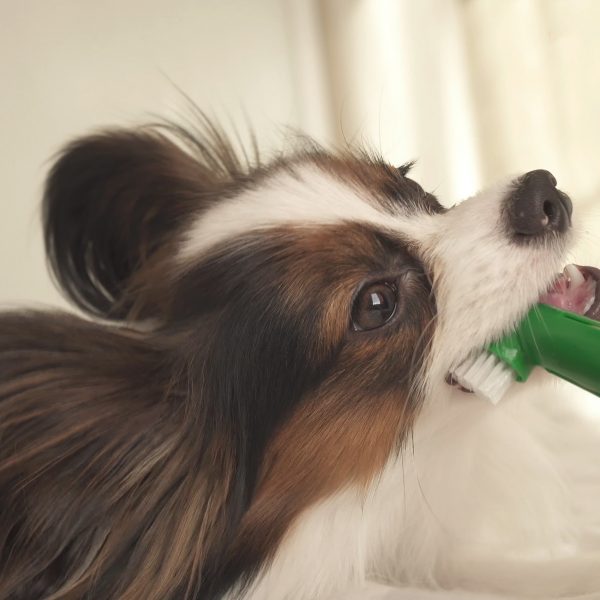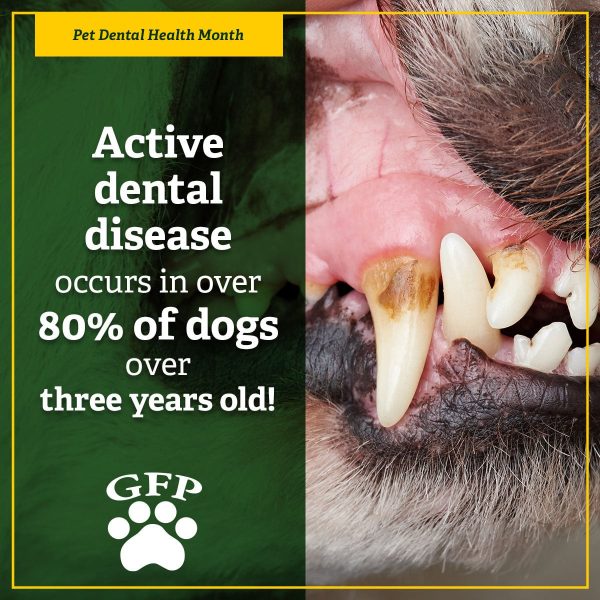What You Should Know About Gum Disease in Dogs

Between their exuberant energy, active lifestyle, and more, your dog may seem like they are in perfect health. But, the unfortunate truth is that your dog is just as vulnerable to illness and disease as you are. When you’re sick, you have the option of going to the doctor for care. When your dog is sick, they rely on you to provide care and take them to the vet for care. Even something as seemingly small as gum disease can cause your dog to suffer and may even lead to more serious problems. Here’s what you should know about gum disease in dogs:
What is Gum Disease in Dogs?
Gum disease in dogs is similar to gum disease in humans. It is also one of the most common health issues in dogs. When a dog has “gum disease”, what they have is gingivitis, which is also called periodontal disease or periodontitis.
When plaque and tartar build up around your dog’s teeth and on their gum tissue, it causes inflammation and infection below the gum line and leads to periodontal disease. This “stealth disease” leads to the erosion of the soft tissues and bone around your dog’s teeth.
If left untreated, it causes gum lines to recede and leads to tooth decay and tooth loss. It may also lead to other serious health issues as bacteria gain access to your dog’s bloodstream and the infection spreads.
How do You Know if Your Dog Has Gum Disease?
There are several symptoms associated with gum disease in dogs. Unfortunately, the signs and symptoms aren’t obvious at first and may only become noticeable when gum disease is already happening. Some may be a sign that your dog is still in the beginning stages of gum disease while others are signs that it is already more advanced.
You should be examining your dog at home and taking them to the vet for regular checkups. During these visits, your vet can help you keep an eye out for any signs of dental issues and catch anything early before it becomes a serious health problem.
Signs of Gum Disease in Your Dog’s Mouth
A lot of dogs have less-than-fresh breath, and bad breath can be a reason why your dog smells bad. But, if your dog’s breath is truly rancid, they could be starting to suffer from gum disease. Bumps or lumps, red or swollen gums, and receding gum lines are signs of inflammation and could be due to tartar buildup, which could indicate gum disease.
Loose teeth, discolored teeth, bleeding gums, bloody saliva, and visible tartar buildup on your dog’s teeth could be signs that gum disease is well underway. You may also see facial swelling in dogs, especially those that develop infections in their mouth. You may also notice blood in your dog’s water bowl or on their toys.
The exception to this is puppy teething. When puppies are teething, it’s normal for them to lose their puppy teeth, experience sore gums as their adult teeth come in, and for a little bit of blood to be present as they go through this change. Your vet can give you some guidelines on what is normal during this stage and what could be a cause for concern.
Gum disease also usually develops over time, so puppies who are teething are generally too young to have it. However, once they are done teething, it’s still important to start them on a dental care routine to prevent gum disease.
Other signs that could indicate gum disease include:
- Excessive drooling
- Swelling below the eyes
- Chronic sneezing or nasal discharge
These symptoms are also common in other underlying health issues. So, if you see any of the above issues, it’s worth a trip to the vet to make sure your dog receives the care they need.
Behaviors That Can Indicate Gum Disease in Your Dog
Gum disease is painful for your dog and only gets more painful the more it progresses. There are several common signs your dog is in pain. It’s important for you to know the signs and pay attention because your dog can’t explain what’s going on when they’re not feeling their best. When it comes to gum disease, you may notice that your dog is sensitive when it comes to their mouth.
Your dog may show a reluctance to eat or play with toys. Chewing may be slow or they may chew with only one side of their mouth. Your dog may also shy away from any petting near their mouth and may even whine or yelp when eating or if you touch their muzzle. Conversely, dogs might grind their teeth in reaction to the oral pain and discomfort.

How Does Gum Disease Affect Your Dog’s Long-Term Health?
Any infection left untreated can spread throughout your dog’s body and cause serious issues. Gum disease doesn’t just affect your dog’s mouth – it also has long-term effects on your dog’s health. Here are a few ways gum disease affects your dog’s long-term health:
1. Tooth Decay, Tooth Loss, and Fractured Jaw
The most common way gum disease affects your dog’s long-term health is in the overall health of their mouth. In addition to tender gums and a lot of pain, gum disease causes bone loss and breaks down your dog’s teeth over time. This can lead to tooth decay that causes painful and dangerous splintered or cracked teeth.
It can also lead to tooth loss from gums receding too far and loosening teeth too much or from teeth needing to be surgically removed. If left untreated, periodontal disease can weaken a dog’s jaw and cause fractures from only a small amount of pressure.
2. Difficulty Breathing
As gum disease advances, especially if it is in the upper teeth, it can erode the bone between the oral and nasal cavities. Essentially, it slowly destroys the separation between your dog’s nose and mouth. This leads to chronic sneezing, nasal discharge, and more, which can all make it difficult for your dog to breathe.
Brachycephalic dogs, which are dogs with short noses or flat faces like Pugs, Pekingese, Chihuahuas, and more, already tend to be sensitive and can have respiratory issues. For these dog breeds, advanced or untreated gum disease only makes it harder for them to breathe properly.
3. Kidney and Liver Disease
Gum disease can also allow bacteria and infection to enter your dog’s bloodstream. As the infection travels to your dog’s kidneys and liver, they may develop diseases or issues in those vital organs.
4. Heart Issues
The bacteria and infection from gum disease can also make their way to your dog’s heart. As with humans, a dog with gum disease also has a higher likelihood of developing heart-related problems.
It can cause endocarditis, which is inflammation of the heart valves, and can also lead to congestive heart failure. This is why practicing good dental care is one of the ways to keep your dog’s heart healthy.
How do You Treat Gum Disease in Dogs?
Gum disease is generally separated into 4 stages. Stage 1 is generally considered to be the beginning stages of gingivitis, while Stages 2-4 are progressions as it advances. Stage 1 is usually relatively easy to treat with regular cleaning and a dental care plan. Stage 2 and Stage 3 are more difficult to reverse.
Although the gums have begun to recede and form “pockets” in Stage 2, there has not yet been a lot of bone loss. Stage 3 is when gums have receded and the pockets around the teeth are more than 5 millimeters. It’s also when bone loss has occurred. When gum disease advances to Stage 4, bone loss is over 50%. At this stage, extracting the tooth is the only option.
X-rays and an exam are required in order to figure out whether gum disease is present and how advanced it is. If it’s caught early enough, your dog can be put under anesthesia so your vet can clean their teeth and remove plaque below the gum line. If periodontal disease is already advanced, they may still need a deep dental cleaning and may also need therapies to help regrow bone and tissue or to have teeth removed completely.
How Can You Prevent Gum Disease in Dogs?
One of the best ways to “treat” gum disease in dogs is to do what you can to prevent it from happening in the first place. Just as you take care of your own teeth and gums, you need to do the same for your dog. Proper dental care for dogs starts with brushing their teeth or using an enzyme toothpaste. Caring for your dog’s teeth every day is good, while twice a day is even better. This will help prevent the tartar and plaque buildup from forming in the first place.
Dental care at home, plus regular checkups and dental cleanings with your vet, can go a long way in helping to prevent gum disease. If your dog may be more prone to dental disease, as small and toy dog breeds are, you can also supplement your dental care efforts with dental hygiene chews or treats approved by your vet. You can even work with your vet to implement a “dental care diet”.
Gum disease can have lasting, painful effects on your dog. You won’t floss your dog’s teeth or get them braces to improve their smile, but you can implement a basic dental care routine early on to help prevent gum disease and maintain good dental health in your dog. Dental care, regular vet visits, and more are all essential costs of owning a dog.
